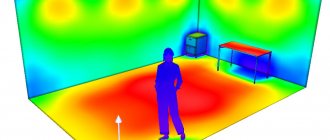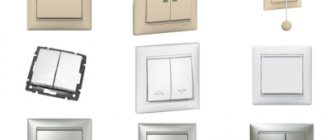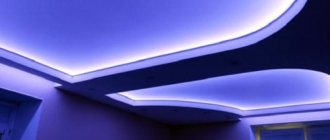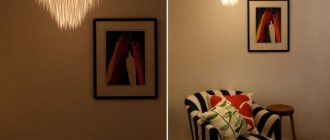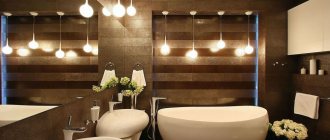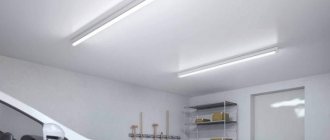If the hardware is familiar: light absorption and reflection coefficients, color rendering index, why ceiling height is important, etc., then go straight to point 5. There we have collected quick ways to calculate illumination. If you do come across unfamiliar words, then spend 30 minutes getting to know the topic now so as not to spend over your budget on repairs later.
Why is it important? Not to mention the fact that dim light spoils vision, and too bright light makes you nervous, lighting is also an inspiration for space. Imagine you spend two weeks choosing a sofa of a certain alabaster shade. You wait another two weeks for delivery, because, of course, there is no such sofa in stock. Finally a sofa at home. You are putting the finishing touches: screwing a light bulb into the floor lamp near the sofa and turning it on. And then your alabaster sofa turns into a stain the color of a dirty puddle.
Remember, an expensive renovation with ill-conceived lighting will look worse than an inexpensive one with beneficial light.
Why is the calculation needed?
It is required to create the most comfortable living conditions due to high-quality and optimal lighting of the entire area of the room. Too strong or weak light flux negatively affects the functioning of the visual apparatus, leading to excessive fatigue, tension or nervousness. Such discomfort will affect the mental state of the person, who will become more irritable and less efficient.
The reference lighting is considered to be solar daylight. With proper calculation, an artificial lighting system consisting of various lamps should bring the light as close as possible to natural light. SNiP specifies lighting standards for each individual room. It is important to take all these values into account when making calculations.
Rules for installing a lighting network in an apartment
And finally, let’s talk about how lighting should be installed in an apartment. We will not tell you how to install wires and make connections, we will talk about the principles of building a control system, and we will suggest several successful solutions that some simply do not know.
Light switch location
- So, first of all, let's start with the location of the switches. The switch for general and decorative lighting should be located on the wall at the entrance to the room. This should be the side closest to the door handle.
- Local lighting should be turned on in the area of its use - usually next to or on the lamp. Zone lighting should be turned on at the entrance to a given zone. If there are two such inputs, then on both sides.
Connection diagram for pass-through and cross switches
- By the way, about controlling lighting from several places. It is quite simple to implement such a circuit using pass-through and cross switches, or using a pulse relay. You will find the principles for installing such circuits on our website.
Types of dimmers
- I would like to devote a few words to such a switching device as a lighting controller in an apartment - or as they are also called: dimmers. Not everyone knows that they can be used to adjust the brightness of not all lamps. For example, diode or fluorescent lamps cannot be adjusted at all.
- And the regulators themselves come in several types, and some can produce quite strong interference. Therefore, before choosing such devices, read the information about them on the pages of our website.
- When choosing switches, do not forget about its rated parameter, such as current. It must match the load on your network. At the moment, switches are produced for currents up to 6 or 10A. Which roughly corresponds to a load of 1300W or 2000W, respectively.
To install the lighting network we use a three-core wire
- Now, regarding the wiring itself. Modern lighting networks usually consume fairly low current. Therefore, compliance with the minimum requirements of the PUE for the group wire will be sufficient. According to the PUE standards, the cross-section of such a wire must be at least 1.5 mm2. For residential premises - this is only copper wire.
- And finally, let us draw your attention to the maximum permissible number of lamps for one switch. Please note: it is lamps, not lamps. This number should be no more than 25 pieces.
Lighting standards for residential and other premises
When organizing a lighting system, you need to study SNiP (building codes and regulations). This is a document that regulates lighting standards for residential and industrial premises. The amount of light can be determined using a lux meter, but often only professionals have such a device. Then, in order to calculate how many lumens are needed per 1 m² of a room, you need to find out its illumination level.
This is interesting! Illumination (Lux) is an important parameter, which means that to illuminate 1 m² you need a certain amount of light. Also for calculations you need to find out the luminous flux of the lamps (Lumens). The relationship between these two parameters is: 1 Lm = 1 Lm/1m².
Lighting standards for habitable rooms in Lux (Lux):
- Bathroom, corridor – 50.
- Utility rooms – 75.
- Bathhouse, swimming pool – 100.
- Living rooms (except children's rooms) – 150.
- To illuminate a children's room you need 200 Lux.
- In the office, home library – 300 Lux.
By calculating the degree of illumination for a certain room, you will know how many Lumens are needed per 1 m², and you can easily calculate the number of lamps.
The standards for workplace lighting according to SNiP in LK look like this:
- Shared office with computers – 300.
- The office where the drawings are created – 500.
- Conference hall – 200.
- Stairs in the corridor, escalator - from 50 to 100.
- Corridors – from 50 to 75.
- Archive room – 75.
- Utility rooms – 50.
Lighting standards are often not met in offices and industrial production, which reduces labor productivity. Typically, general (ceiling lamps) and local light (wall or table fixtures) are used for workers. These lighting devices allow you to evenly illuminate the entire area and separately each workplace. When organizing local illumination, you need to take into account the age and visual acuity of each employee.
The functionality of the human visual system depends on the level of illumination. For example, at 750 – 5000 Lux the performance of the visual system is accurate, at 200 – 300 Lux it is average, at 200 – 150 Lux it is low. It is important to strive for high performance in order to improve employee performance and reduce defects and injuries.
Inaccuracies and errors when calculating LED lighting
The formulas discussed cannot be called complete, since there are many more factors that influence the quality of light. We have listed some above, but they can be supplemented by a number of others:
- reflectivity coefficient of various finishing materials and surfaces;
- physical and technical parameters of a specific lamp;
- presence of diffusers and reflectors;
- room index;
- Room efficiency, etc.
It is impossible to achieve one hundred percent accuracy in calculations. Even if they are performed by highly qualified engineers, certain assumptions will still have to be made or generally accepted averages must be used. And the standards written in SNiP cannot be called strict and justified, since there will always be a difference between the desired and possible results.
Main conclusions
Artificial light is of great importance for humans; it should resemble natural light as much as possible. Otherwise, the person suffers from headaches, drowsiness, irritability, decreased performance, and blurred vision. To avoid this, you need to find out how many lumens per 1 m² you need. To do this, you should study the illumination standards of a certain room, do not confuse Lm with Lk and carefully carry out the calculation. Then you can correctly determine the number of lighting fixtures for uniform illumination. To adjust the brightness of the light, install a separate switch for each lamp.
How do we calculate?
To calculate the number of lamps required for a room, you must follow the principle of rounding fractions up. This means that when getting, for example, a value of 36 W for a small corridor, it is better to use two 25 W bulbs than one 40 W. Note! In this matter, it is also necessary to evaluate the color scheme of the room. If there are dark tones in the design, preference should be given to brighter light sources. To obtain specific numbers, you must use the formula for calculating spots. Here, to calculate the optimal level of required lighting, the following formula is used: N = (S * W) / P, where these indicators denote the following values:
- N is the number of lamps available in the room. Measured in pieces;
- S – area of available premises. Measured in sq.m;
- W is the specific power of the luminous flux emitted by the bulbs. The parameter indicates the level that is necessary to create optimal lighting. This indicator is different for each lamp. Measured in W/sq.m;
- P – power for one lamp. Measured in Watts.
Remember that the figures obtained during the calculations may fluctuate slightly, but they will still be as close as possible to the real single parameters. To make it clear, we give an example of calculations. Let's select the following parameters:
- type of room - living room;
- type of lighting - basic;
- type of lamps - LED;
- spot power (average) – 5 W;
- room area – 20 m2.
The specific power indicator is taken from the table or calculated approximately as indicated above. For an LED lamp it is W = 3 W/sq.m. We insert all the indicators into the formula and get N = (20 * 3) / 5 = 12 pcs. You can also use another formula to determine illumination:
Living room lighting
P=pS/N, where the indicators are deciphered as follows:
- P – illumination;
- p – specific lighting power. For incandescent lamps, the average value p = 20 W/m2, for halogen lamps - 30 W/m2, for fluorescent lamps -10 W/m2, for LED lamps -3 W/m2. Measured in W/m2.;
- S – area of a specific room in m2;
- N – number of available lamps.
Using the above formulas, you can easily calculate the required number of light bulbs for each room in your house or apartment.
Light level detection
Let's look at how to calculate the glow intensity for a specific room. The formula is as follows: Ф = R * S * L, where:
- R – illumination per 1 sq. m;
- S – area of the room;
- L – safety factor.
The safety factor is related to the mounting height of the luminaires and the reflectivity of the walls, ceiling and floor on which the light falls. In living rooms, when using LEDs, the safety factor is 1.1.
For example, consider calculating the glow intensity in a bedroom with an area of 8 square meters. m. Illumination (R) is taken from the list above (chapter “Room illumination standards”).
As an example, consider the calculation of LED bedroom lighting:
- F = 200 * 8 * 1.1 = 1760 lm
Based on the obtained value, we come to the conclusion: the total value of the luminous flux of all light sources used should be close to 1760 lm. We remind you of the negative effects of both excessive and insufficient lighting.
How to achieve uniform lighting?
When choosing a location for installing LED devices, you need to focus on the amount of luminous flux. The higher the value of this parameter, the greater the distance between the lamps. To cover the entire area of a room or a specific area, you first need to calculate the required number of lamps.
To create uniform lighting, you need to use different types of lighting fixtures. There are many combinations:
- A chandelier is installed as a central lamp. The luminous flux is supplemented by point sources scattered across the ceiling in different patterns.
- Several main light sources are attached to the ceiling, which are complemented by decorative lighting made from flexible tape.
- Only point devices with the most suitable characteristics are mounted on the ceiling. The chandelier is not used.
Ratio Watt, Lumen, Lux
Just 10 years ago, it was easier to choose a suitable light bulb, since the maximum power was indicated on each device. Nowadays, filament-based devices are being replaced by energy-saving ones, the power values of which have completely changed. Now, when choosing lamps, you should take into account the illumination (Lx) and luminous flux (Lm).
Interesting! Some people continue to choose light bulbs based on power, but this is not true. Watts indicate the amount of energy that a device consumes, but does not indicate the level of luminous flux.
To determine the amount of light, you need to pay attention to Lux and Lumen. Many consumers still confuse these important meanings. The first indicator indicates the surface on which the light falls, and the second indicates the luminous flux of the light bulb. A device with a light power of 1 Lumen qualitatively illuminates 1 m², creating an illumination of 1 Lux. That is, Lk shows the ratio of the amount of Lm and the illuminated area.
Below is a table that helps convert Watts into lumens for different types of lamps:
| Filament lamp, power (W) | Luminescent, power (W) | LED, power (W) | Luminous power (Lumens) |
| 20 | 5 – 7 | 2 – 3 | Up to 250 |
| 40 | 10 – 13 | 4 – 5 | Up to 400 |
| 60 | 15 – 16 | 8 – 10 | Up to 700 |
| 75 | 18 – 20 | 10 – 12 | Up to 1000 |
| 100 | 25 – 30 | 12 – 15 | Up to 1300 |
| 150 | 40 – 50 | 18 – 20 | Before 1800 |
| 200 | 60 – 80 | 25 – 30 | Up to 2500 |
This table shows that the energy requirements of different types of appliances are different. However, it shows only approximate parameters that can be used to find out how many lumens are needed per 1 m².
For approximately 1 W of energy consumed, a conventional light bulb can emit 8 – 2 Lm. This difference can be caused by many reasons, for example, the devices are made of different materials, they are damaged during transportation, etc.
This is interesting! The illumination standards that Russia is guided by were adopted a long time ago, so often calculations using them do not bring the desired result, that is, there is not enough light. To avoid this, when determining the number of lumens per 1 m², it is recommended to increase all values by 1.5 times. For convenience, it is worth installing several switches in the room for different lamps to regulate the light intensity.
Innovative devices
More and more people are changing their choice from traditional incandescent lamps in favor of LED lamps. They, some time ago, were considered unacceptable light sources that could be used in an apartment or house. With the growth of production capacity and science, they began to pose significant competition to standard lighting devices.
Their ability to compete is explained by the following factors:
- The service life of the lamp is much longer compared to a conventional one;
- LED lamp consumes less energy than halogen and incandescent lamps;
- The LED lamp does not heat up when used for a long time, which allows it to be used better and more creatively in interior design.
If previously this device did not have the opportunity to compete with other lighting devices, now the manufacturers have tried. The market is saturated with lamps of various lighting levels, energy consumption and spectrum. Anyone can purchase exactly the product they need.
An important role is played by the fact that LED lamps are more environmentally friendly than their predecessors. They do not create fluctuations in the light flux, and they do not emit ultraviolet radiation.
Many experts advise using LED lamps when planning a room. However, it is necessary to take into account the fact that it is possible to purchase low-quality products. When purchasing a product, it is recommended to pay attention to the manufacturer's brand. As a rule, the more famous it is, the higher quality products it produces.
Independent calculation of the required amount of light and lighting fixtures
To obtain uniform illumination, you need to calculate the total power (electric or light), the number of lamps and luminaires. The calculation must be made taking into account the following factors:
- Type of room (bedroom, bathroom, office).
- Ceiling height.
- Color scheme of walls, furniture and floors.
- Presence of a mirror.
The level of lighting per square meter depends on the functional purpose of the room. What is good for a bedroom is too dim for a living room or kitchen, and vice versa.
Attention! To find out how many Lumens are needed per 1 m², you should take into account the height of the ceilings. The standard for calculations is a height of up to 3m. If this indicator ranges from 3 to 4 m, then multiply the result by 1.5, and if more than 4 m, multiply by 2.
There are two ways to calculate the amount of light for a specific room:
- Taking into account electrical power.
- By luminous power.
For each method, different standard values, formulas, and units of measurement are used.
Calculating illumination taking into account electrical power is a simple but not very accurate method. To carry it out, you need to know the area of the room and the required number of watts per square meter. To calculate the area, use the formula: S = a x b. Then multiply the required number of W per 1 m² (on average this figure is 20 W) by the area. For this, the following formula is used: P (total power) = S x P (nominal power for 1 m²).
You can then determine the number of fixtures for the room. To do this, divide the total power by this value for one light source. For example, if you need to illuminate a room with a total power of 300 W using lamps with a 75 W filament, then carry out the calculation: 300 : 75 = 4. That is, for illumination you need 4 75 W lamps.
Experts say that the 20 W standard is not accurate. To make the calculations correctly, use separate values for different rooms: for the living room - from 10 to 35 W, for the kitchen - from 12 to 40 W, for the bathroom - from 10 to 30 W, for the bedroom - from 10 to 20 W. This data is for filament lamps. If you want to use housekeepers, then pay attention to the packaging, which indicates what power of a regular lamp this device corresponds to.
Experts advise carrying out calculations taking into account the luminous flux (Lm). This method gives more accurate results, although not all people are used to it. To find out how many Lumens are needed per 1 m², you need to know the lighting standards for a particular room.
